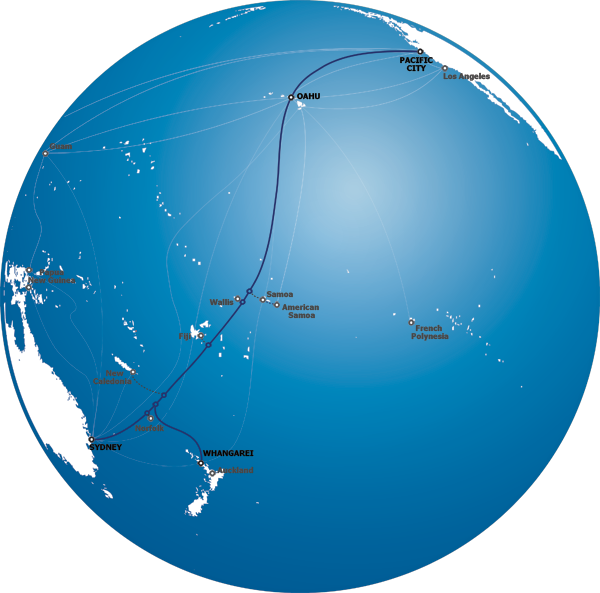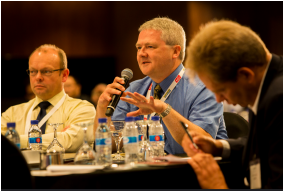Hawaiki Cable Announces Contract for Cable System has Come Into Force and Construction Commences6/14/2016 Hawaiki Submarine Cable LP and TE SubCom, a TE Connectivity Ltd. company and an industry pioneer in undersea communications technology, are pleased to announce that the contract for the Hawaiki submarine cable system has come into force and the construction phase has commenced. Figure 1 - Hawaiki Cable MapSource: Hawaiki The Hawaiki submarine cable system is a new trans-Pacific cable, which will link Australia and New Zealand to mainland United States, as well as Hawaii, with options to expand to several South Pacific islands. Permitting and initial route planning began in June 2015 and the system will be completed by mid-2018.
The 14,000 km cable system will deliver more than 30 Tbit/s of capacity via TE SubCom’s C100U+ Submarine Line Terminating Equipment (SLTE) and will allow for optional connectivity to islands along the route utilizing TE SubCom’s industry leading optical add/drop multiplexing (OADM) nodes. Sir Eion Edgar and Remi Galasso, the co-developers of the project, have entered into a long-term partnership and joined forces with entrepreneur Malcolm Dick, to fund and operate the multimillion dollar cable system. Hawaiki will be a privately-owned and carrier-neutral cable for the Pacific region. “This is a fantastic achievement for the team. We are delighted to move to the implementation phase and pursue our collaboration with TE SubCom,” said Galasso, chief executive officer of Hawaiki. “They have demonstrated a full commitment to the project since the early stages of development and are a true partner of Hawaiki.” Sir Eion added, “This is the beginning of a new era for New Zealand and the Pacific Islands in terms of international connectivity. We are excited to be at the forefront of this very significant infrastructure investment.” "The lack of an alternative cable system connecting Australia, New Zealand, and the U.S. has long been a concern of mine, so I am delighted to be part of this project,” said Dick. “Having built telco businesses in both Australia and New Zealand in the past, I am very aware of the need to provide competition by being independent of the incumbent operators. This increased level of competition and capacity should make data caps a thing of the past.” “The Hawaiki cable system will enhance international capacity for New Zealand and Australia directly to the U.S., providing them with a vital communication advancement that the region has been in need of for quite some time,” said Aaron Stucki, president of TE SubCom. “We are honored to play a key role in a project that will undoubtedly help support the economic development in the region thanks to this state-of-the-art infrastructure.” Thanks to its cutting edge architecture, Hawaiki will be the fastest link between Sydney and the U.S. West coast and provide Australia, the largest capacity market in the South Pacific region, with a powerful solution. It will also provide New Zealand with direct connectivity to Australia and the U.S., providing an alternative route between Hawaii and Oregon. This route also allows for a diverse and secure route from existing systems. Source: TE SubCom Press Release ANALYSIS: This announcement comes as a surprise to the industry as only six months ago, Hawaiki admitted that they had an equity funding gap of US$150M. It is not clear at this stage how this gap has been bridged but there has been evidence over the last couple of years that TE SubCom is willing to offer vendor financing. The most recent example of this was a short-term loan to bring the construction contract for Aquacomm's transatlantic "AE Connect" cable into force. A common characteristic of these two projects is the industry's low opinion of the management team's capability in both cases. Nevertheless, the concept of an Australia-New Zealand-US West Coast cable to challenge the long-held monopoly of Southern Cross is a sound one. Southern Cross has done everything possible to discourage investment in new systems, most notably by implementing significant wholesale bandwidth price reductions and upgrading the system to use the latest technology. Southern Cross may still make another price cut to make lenders to the Hawaiki project think twice but Southern Cross' "fire power" may be waning. Further challenges lie ahead for Hawaiki. They have signed a landing party agreement with Tillamook Lightwave for access to their Pacific City cable landing station in Oregon which is known for its transparent and efficient permitting process. However, Team Telecom is handling a number of license applications at the moment and there may be delays. Furthermore, the backhaul from Pacific City to Silicon Valley is known to be under-developed and may need additional investment to bring it up to service levels expected by the carriers and content providers who are likely to be customers on the Hawaiki cable.
0 Comments
Leave a Reply. |
Julian Rawle, AuthorThought leadership articles and commentary on developments related to the subsea fibre optic cable industry can be found here. Archives
February 2018
Categories |




 RSS Feed
RSS Feed